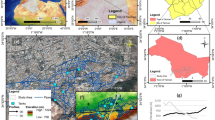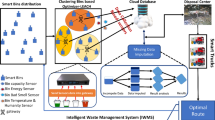Abstract
When a leakage event occurs, the values of pressure sensors in the water distribution network will drop, and leakage alarms will be triggered if the drop in pressure values exceed the alarm thresholds. Due to the similarity of the leakage characteristics between the adjacent nodes, it is difficult to identify the exact leakage node. Therefore, in this paper, a leakage zone identification method based on alarm levels and pattern identification is proposed. At first, leakage residual samples for each node are generated within the range of the leakage amount. To reduce the influence of nodes with similar leakage residual characteristics on the identification results, the residual values of each sample are converted into alarm levels. For the training samples, nodes with the same alarm level sample are merged into a node group and used as a label. Then, the Euclidean distance method is used to test the identification effect of the model. The enumeration method is adopted to optimize the sample interval, the alarm level interval and the feature dimension to enable the model to achieve an appropriate identification result. A life-sized network is presented in this paper to demonstrate the effectiveness of the proposed method. The results show that compared with the previous leakage zone identification method based on alarm characteristics, the proposed method can effectively reduce the size of the candidate leakage zone.










Similar content being viewed by others
References
OECD (The Organisation for Economic Co-operation and Development) (2012) OECD environmental outlook to 2050: the consequences of inaction. OECD Publishing, Paris
China Urban Water Association (2015) Statistical yearbook of urban water supply. China Statistical Press, Beijing
Al Qahtani T, Yaakob MS, Yidris N et al (2020) A review on water leakage detection method in the water distribution network. J Adv Res Fluid Mech Therm Sci 68:152–163
Xie X, Hou DB, Tang XY et al (2019) Leakage identification in water distribution network with error tolerance capability. Water Resour Manag 33(3):1233–1247
Gao Y, Brennan MJ, Liu Y et al (2017) Improving the shape of the cross-correlation function for leak detection in a plastic water distribution pipe using acoustic signals. Appl Acoust 127(12):24–33
Coster AD, Medina J, Nottebaere M et al (2019) Towards an improvement of GPR-based detection of pipes and leaks in water distribution networks. J Appl Geophys 162:138–151
Li MH, Feng X (2022) Multisensor data fusion-based structural health monitoring for buriedmetallic pipelines under complicated stress states. J Civ Struct Health. https://doi.org/10.1007/s13349-022-00609-w
Wu ZY, Sage P, Turtle D (2010) Pressure-dependent leak detection model and its application to a district water system. J Water Resour Plann Manage 136:116–128
Geng ZQ, Hu X, Han YM et al (2019) A novel leakage-detection method based on sensitivity matrix of pipe flow: case study of water distribution systems. J Water Resour Plan Manag 145(2):04018094
Sanz G, Pérez R, Kapelan Z et al (2015) Leak detection and localization through demand components calibration. J Water Resour Plan Manag 142(2):04015057
Moasheri R, Ghazizadeh MJ, Tashayoei M (2021) Leakage detection in water networks by a calibration method. Flow Meas Instrum 80(24):101995
Soldevila A, Fernandez-Canti RM, Blesa J et al (2017) Leak localization in water distribution networks using Bayesian classifiers. J Process Contr 55:1–9
Kang J, Park YJ, Lee J et al (2018) Novel leakage detection by ensemble cnn-svm and graph-based localization in water distribution systems. IEEE Trans Ind Electron 65(5):4279–4289
Guo GC, Yu X, Liu SM (2020) Leakage detection in water distribution systems based ontime–frequency convolutional neural network. J Water Resour Plan Manag 147(2):04020101
Zhou X, Tang ZH, Xu WR et al (2019) Deep learning identifies accurate burst locations in water distribution networks. Water Res 166(12):115058
Qi ZX, Zheng FF, Guo DL et al (2018) Better understanding of the capacity of pressure sensor systems to detect pipe burst within water distribution networks. J Water Resour Plan Manag 144(7):04018035
Rossman LA (2020) EPANET 2.2 online user’s manual. National Risk Management Research Laboratory, U.S. EPA, Cincinnati
Qi R, Li XP, Zhang Y (2020) Multi-classification algorithm for human motion recognition based on IR-UWB radar. IEEE Sens J 20(21):12848–12858
Kapelan ZS, Savic DA, Walters GA (2015) Multiobjective design of water distribution systems under uncertainty. Water Resour Res 41(11):97–116
Pacchin E, Alvisi S, Franchini M (2017) Analysis of non-iterative methods and proposal of a new one for pressure-driven snapshot simulations with EPANET. Water Resour Manag 31(1):75–91
Van Zyl JV, Cassa AM (2014) Modeling elastically deforming leaks in water distribution pipes. J Hydraul Eng 140(2):182–189
Li JD, Cheng KW, Wang SH et al (2017) Feature selection: a data perspective. ACM Comput Surv 50(6):1–45
Li X, Chu SP, Zhang TQ et al (2022) Leakage localization using pressure sensors and spatial clustering in water distribution systems. Water Supply 22(1):1020–1034
Zhang QZ, Wu ZY, Zhao M et al (2016) Leakage zone identification in large-scale water distribution systems using multiclass support vector machines. J Water Resour Plann Manage 142(11):04016042
Shao Y, Li X, Zhang TQ et al (2019) Time-series-based leakage detection using multiple pressure sensors in water distribution systems. Sensors 19(14):3070
Acknowledgements
This work was supported by the National Natural Science Foundation of China (Grant No.52079024), the Fundamental Research Funds for the Central Universities (Grant No. DUT20LAB133) and the National Key Research and Development Program of China (Grant No. 2016YFC0802402).
Author information
Authors and Affiliations
Corresponding author
Additional information
Publisher's Note
Springer Nature remains neutral with regard to jurisdictional claims in published maps and institutional affiliations.
Rights and permissions
Springer Nature or its licensor holds exclusive rights to this article under a publishing agreement with the author(s) or other rightsholder(s); author self-archiving of the accepted manuscript version of this article is solely governed by the terms of such publishing agreement and applicable law.
About this article
Cite this article
Chen, J., Feng, X. & Xiao, S. Leakage zone identification for water distribution networks based on the alarm levels of pressure sensors. J Civil Struct Health Monit 14, 15–27 (2024). https://doi.org/10.1007/s13349-022-00624-x
Received:
Accepted:
Published:
Issue Date:
DOI: https://doi.org/10.1007/s13349-022-00624-x




